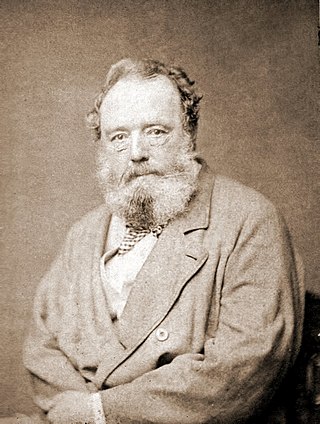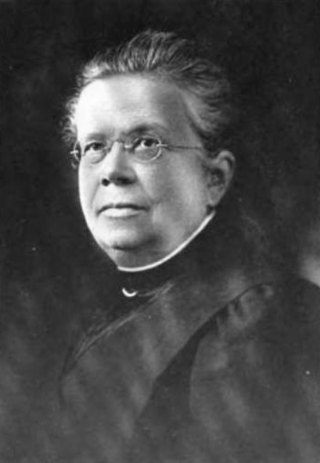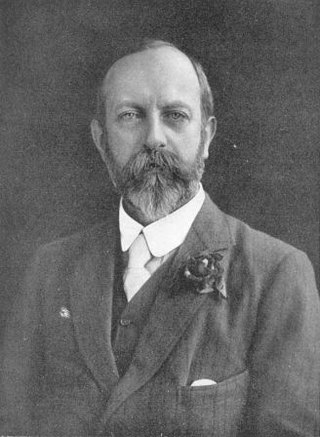
Microscopy is the technical field of using microscopes to view objects and areas of objects that cannot be seen with the naked eye. There are three well-known branches of microscopy: optical, electron, and scanning probe microscopy, along with the emerging field of X-ray microscopy.

Sir Frank Crisp, 1st Baronet, was an English lawyer and microscopist. Crisp was an enthusiastic member, and sometime officer, of the Royal Microscopical Society. He was generous in his support of the Society, donating furniture, books and instruments in addition to his work on technical publications.
Rev. Joseph Bancroft Reade FRS FRMS was an English clergyman, amateur scientist and pioneer of photography. A gentleman scientist, Reade co-founded the Royal Microscopical Society and the Royal Meteorological Society.

Edwin Lankester FRS, FRMS, MRCS was an English surgeon and naturalist who made a major contribution to the control of cholera in London: he was the first public analyst in England.

Lionel Smith Beale was a British physician, microscopist, and professor at King's College London. He graduated in medicine from King's College in 1851. He was elected a Fellow of the Royal Society in 1857.

Mordecai Cubitt Cooke was an English botanist and mycologist who was, at various points, a London schoolteacher, a Kew mycologist, curator at the India Museum, journalist and author,. Cooke was the elder brother of the art-education reformer Ebenezer Cooke (1837–1913) and father of the book illustrator and watercolour painter William Cubitt Cooke (1866–1951).

Science-Gossip was the common name for two series of monthly popular-science magazines, that were published from 1865 to 1893 and from 1894 to 1902. The first series was called Hardwicke's Science-Gossip, and the second series Science-Gossip.

The Royal Microscopical Society (RMS) is a learned society for the promotion of microscopy. It was founded in 1839 as the Microscopical Society of London making it the oldest organisation of its kind in the world. In 1866, the society gained its royal charter and took its current name. Founded as a society of amateurs, its membership consists of individuals of all skill levels in numerous related fields from throughout the world. Every year since 1841, the society has published its own scientific journal, the Journal of Microscopy, which contains peer-reviewed papers and book reviews. The society is a registered charity that is dedicated to advancing science, developing careers and supporting wider understanding of science and microscopy through its Outreach activities.
The Journal of Cell Science is a peer-reviewed scientific journal in the field of cell biology. The journal is published by The Company of Biologists. The journal is partnered with Publons, is part of the Review Commons initiative and has two-way integration with bioRxiv. Journal of Cell Science is a hybrid journal and publishes 24 issues a year. Content over 6 months old is free to read.

John Thomas Quekett was an English microscopist and histologist.

William Lens Aldous was a British illustrator who reproduced findings of the early workers in microscopy, and an early member of the Royal Microscopical Society.
Edwin John Quekett FRMS (1808–1847) was an early worker in botany and histology, and a microscopist.
Andrew Pritchard FRSE was an English naturalist and natural history dealer who made significant improvements to microscopy and studied microscopic organisms. His belief that God and nature were one led him to the Unitarians, a religious movement to which he and his family devoted much energy. He became a leading member of Newington Green Unitarian Church in north London, and worked to build a school there.

Mary Ann Allard Booth was an American microscopist.
David Lawrence Bryce FRSE (1852-1934) was a Scottish marine zoologist and specialist in Rotifera.
Vida Annette Latham (1866–1958) was a British-American dentist, physician, microscopist, and researcher, known for her work in publishing and her research on oral tumors, surgery, and anatomy.
The American Microscopical Society (AMS) is a society of biologists dedicated to promoting the use of microscopy.
The International Federation of Societies for Microscopy is an international non-governmental organization representing microscopy. It currently has 37 national members and 9 associate members, which are split into three regional committees, the Committee for Asia-Pacific Societies of Microscopy, the European Microscopy Society and the Interamerica Committee for Societies for EM.

Edward Alfred Minchin was a British zoologist who specialised in the study of sponges and Protozoa. He became Jodrell Chair of Zoology at University College London in 1899, Chair of Protozoology at the University of London in 1906, and was elected a Fellow of the Royal Society in 1911.

Tweedy John Todd (1789–1840) was an English doctor, Royal Navy surgeon and naturalist who conducted early experimental work on healing and regeneration in animals.











